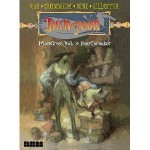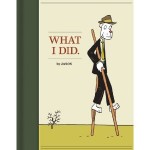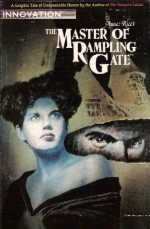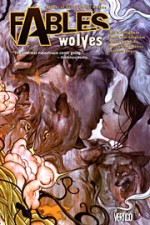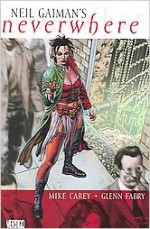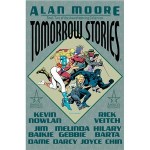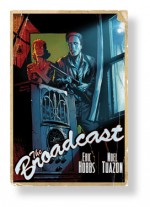
By Will Eisner, Jules Feiffer & Wally Wood (Kitchen Sink Press)
ISBN: 0-87816-012-4
In keeping with the dolorous nature of this time of year I’m concentrating on a few missed opportunities in this period between the dubious joys of Christmas and the nervous anticipation of the New Year so here’s a graphic novel that in some ways didn’t live up to all it could have been – not necessarily because of the material itself but because of the kind of world we live in…
It is pretty much accepted today that Will Eisner was one of those pivotal creators who shaped the American comic book industry, with most of his graphic works more or less permanently in print – as they should be. However, although the story can be found as part of the recent Spirit Archive volume 24, this classy monochrome volume from much-missed independent publisher Kitchen Sink in 1983 released in both hardback and softcover, is by far a better reading experience.
Sometimes the Medium is the Message, especially when the artefact is a substantially solid tome delivering magical artwork in crisp, breathtaking black and white which details – not only in the reprinted strips but also sketches, incidental artwork and author’s breakdown layouts – the last and most striking saga of one of the world’s greatest fantasy characters.
From 1936 to 1938 Eisner worked as a jobbing cartoonist in the comics production firm known as the Eisner-Eiger Shop, creating strips for both domestic US and foreign markets. Using the pen-name Willis B. Rensie he created and drew opening instalments for a huge variety of characters ranging from funny animal to historical sagas,
Westerns, Detectives, aviation action thrillers… and superheroes – lots of superheroes …
In 1940 Everett “Busy†Arnold, head honcho of the superbly impressive Quality Comics outfit, invited Eisner to take on a new challenge. The Register-Tribune newspaper syndicate wanted a 16-page weekly comicbook insert to be given away with the Sunday editions. Eisner jumped at the opportunity, creating three strips which would initially be handled by him before two of them were handed off to his talented assistants. Bob Powell inherited Mr. Mystic and distaff detective Lady Luck fell into the capable hands of Nick Cardy (then still Nicholas Viscardi) and later the inimitable Klaus Nordling.
Eisner kept the lead feature for his own playground and over the next twelve years The Spirit became the most impressive, innovative, imitated and talked-about strip in the business. However, by 1952 he had more or less abandoned it for more challenging and certainly more profitable commercial, instructional and educational strips, working extensively for the US military in manuals and magazines like P*S, the Preventative Maintenance Monthly, and generally leaving comics books behind.
For the final year or so the bulk of Spirit tales were produced by other hands with assistant Jules Feiffer handling the bulk of the scripts and diverse artists producing the art. Feiffer preferred to map out his episodes in rough pencil with word balloons and captions fully scripted: once approved by Eisner the roughs would then be interpreted by the assigned artist for the individual episodes. The long-term plan was not to cancel The Spirit but to redefine it for a new decade and expand the Eisner studio/company beyond and around it – but that’s not quite how it played out.
As seen in the scholarly introduction by Cat Yronwoode and Eisner’s own director’s commentary ‘Reminiscence’, the plans to reposition The Spirit were not welcomed by the client papers buying the strip; the creators handling the feature had different creative goals and drives and Eisner himself couldn’t quite let go of his precious baby.
Even though society and comicbooks were wildly in love with the bold new genre of space opera science fiction and Eisner had previously dabbled with the form in a few previous adventures, a large number of Spirit clients and readers did not want any “flying saucer spacey stuff†on their Sunday funnies pages. Moreover the brilliantly sardonic, existentialist and sensitively satirical Feiffer was approaching the tales in a bleak, almost nihilistic way, emphasising existentialist isolation, human frailty and the passing of an era rather than rugged he-men with hot babes in bikinis and fishbowl helmets…
After a succession of fill-in draughtsmen Wally Wood was selected as artist, a stunningly gifted imaginer who had been reaching unparalleled heights with his work for EC and other comicbook Sci Fi publishers. Wood had actually begun his professional career on the Spirit in the 1940s as a letterer and was fantastically keen on the new project, but the merciless deadlines and his overwhelming desire to surmount his own high standards soon had the saga experiencing deadline problems on top of everything else…
After the text features, the first episode ‘Outer Space’ begins, preceded as are most of the strips here by Feiffer’s meticulous and detailed script layouts. First appearing on Sunday, July 27th 1952, it saw Denny Colt, The Spirit, managing a crew of convict volunteers on an American rocketship to the moon, at the insistent request of eminent space scientist Professor Hartley Skol. However this was a new hero for an uncertain age. The tough, fun-loving, crime-fighting daredevil had become a cautious, introspective leader, feeling fully the weight of his mission and the burden of unwelcome responsibilities.
‘Mission: the Moon’ (August 3rd 1952), follows Colt, Professor Skol and the pardoned felons onto the satellite’s barren surface and recounts the Spirit’s first victory as he heads off a potential mutiny with reason, not force, whilst ‘A DP on the Moon’ reveals how closely Eisner still monitored the series.
DP’s were “Displaced Persons†a common term in the post-war world, and when the explorers find a diary in the lunar dust, it reveals that the world’s greatest dictator and his inner circle fled to the moon to escape Allied justice. Unfortunately they could not outrun their own paranoia and madness…
In the original script and finished art the diarist is Adolf Hitler, but the grim fate that befell his fellow Nazis was altered at the very last moment by Eisner, who felt the plot already old hat. Swift retouching transformed Der Fuehrer into fictitious Latin American dictator Francisco Rivera and the revised version ran on August 10th 1952. It still reads well but if you look carefully those uniforms in the background flashbacks are hauntingly familiar…
With ‘Heat on the Moon’ the deadline crunch hit, and one and a half pages of spectacular Lunar exploration by Wood abruptly segue to a “meanwhile back on Earth†scene by Eisner, featuring Chief Dolan, daughter Ellen and a criminal with a vested interest in assuring that at least one of the moon volunteers isn’t pardoned.
Following their first fatality the mission began to go swiftly awry and ‘Rescue’ (the instalments now cut to only four pages in an attempt to fight the deadline doom) saw another body-blow to the expedition. Defeated and demoralised Spirit decided to return the survivors to Earth…
‘The Last Man on the Moon’ depicted the launch from the moon as on Earth another gangster attempted to scotch the return trip. The mission, clearly cursed, suffered one more disaster as a convict sneaks away before take-off, becoming, with the September 7th episode ‘The Man in the Moon’.
On September 14th the inevitable occurred and the feature was forced to run a modified reprint (‘The Amulet of Osiris’ from the late 1940s) before Wood resurfaced to illustrate the philosophically barbed ‘Return from the Moon’ on September 21st. As Denny Colt and the remaining lunar-nauts debate the nature of reality, Eisner stepped in with the help of Al Wenzel to produce ‘The Return’ a hasty wrap-up that still found room for a close encounter with a flying saucer.
A scheduling blip saw an alternate version of the return a week later (not included here) and the last episode ‘Denny Colt, UFO Investigator’ ran on October 5th 1952: an inconclusive new beginning illustrated by Klaus Nordling. The strip died with that episode as Eisner, increasingly occupied with military work, and bleeding client-papers, terminated the feature.
But that isn’t quite the end: this book also includes in various forms what would have been the next three chapters, discovered in Eisner’s extensive file vault in the early 1980s. First is a fully lettered Feiffer layout, followed by a sequence of lettered pages prior to the art being drawn and the first (and only) typed script from assigned new creator Nordling.
Tense, suspenseful, dark and fearsomely compelling, these are the stories that killed off the Spirit for nearly two decades, but today they stand as a mini-masterpiece of modern comics storytelling that was quite simply, too far advanced for its audience. For we survivors of Cold War, Space Race and Budget-cut scientific exploration they are a chilling and intensely prophetic examination of human nature in a Brave New World rendered with all the skill and frantic passion of some of comics’ greatest talents.
What wonders could have followed if the readers had come along with them?
© 1983 Kitchen Sink Press. © Art and stories 1983 Will Eisner. All rights reserved.

